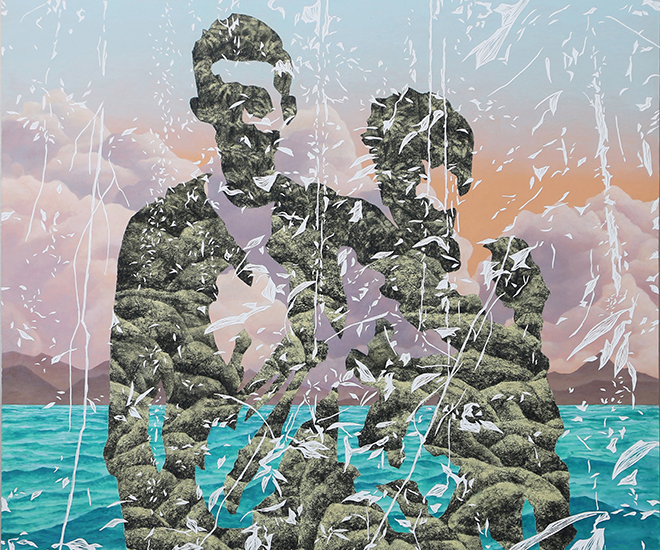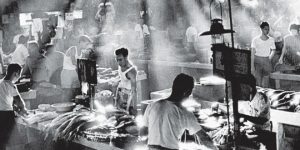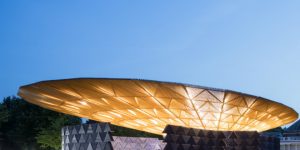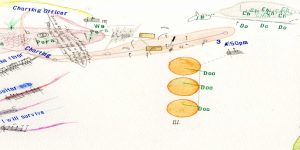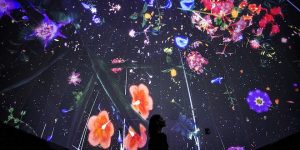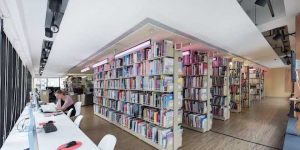An Open Show: ‘Labyrinth’ solo show by Jason Wee
Singaporean artist and poet Jason Wee presents his first solo exhibition, ‘Labyrinths’

Jason Wee, Labyrinths, 2017. Image courtesy the artist and Yavuz Gallery.
The works in Jason Wee’s latest solo, ‘Labyrinths’, at Yavuz Gallery, are based on the visual form of everyday temporary fence that is used in the Singapore landscape. Producing both an installation of fragmented fences and a series of wall reliefs, the show explores the metaphor of a labyrinth as a space for exploring the state of our country.
For Wee, both poet and artist, the multiple myths of the labyrinth would be familiar. One labyrinth that is welcome to the learned is the library. In this labyrinth, visitors are less interested in getting out and more interested in getting lost. Tall bookshelves filled with books cast blinders to the visitors’ line of sight. Nonetheless, this is a welcome restriction: the desire to navigate this labyrinth quickly is ceded by the need to navigate this labyrinth enjoyably. Free from the eyes of the world, the visitor of the library is free to get lost in the space or pages of the books, unrestricted.

Jason Wee, Labyrinths (Open Fire), 2017. Image courtesy the artist and Yavuz Gallery.
The labyrinth made up of fences, however, is different in many ways from the library’s labyrinth. Wee’s ‘Labyrinths’, a site-specific installation, utilises open fences, which are porous and unadorned by books or other forms of diversion. By looking at the fence, I simultaneously look through it to the other side. Unlike the bookshelf, the fence does not hold its viewer back. My eye is unobstructed, free to look through to see the size, shape and ends of the labyrinth. From the viewpoint of the installation image, my eye traverses through the green fence to the white fence behind it and then past that to the blue fence fixed on the gallery wall. Arguably, it is also through the fence that the gallery white cube space is articulated and given depth.
‘Labyrinths’ stands sparse and skeletal, denying me the diversion of a never-ending library. My far gaze demystifies ‘Labyrinths’. Yet it is also through this process of finding efficiency that I become lost. With ‘Labyrinths’, I constantly look over the fence, mentally exploring the space and thinking about the best way out of it. This process raises awareness about how fences and barricades in general discipline my body. In giving physical form to an open labyrinth, the fences demonstrate how it has denied me the freedom of cutting through the gallery space quickly. This is a labyrinth that literally shows itself as a form of obstruction, a labyrinth that is a source of frustration.

Jason Wee. Image courtesy Yavuz Gallery
By my imagining, ‘Labyrinths’ seems closer to the home of the Minotaur. In the installation, the oversized fence looms up high between the people on the other side and I. It was particularly strange to experience his artist talk moderated by Lim Qinyi, Curator at National Gallery Singapore, in this space. Both Wee and Lim sat beyond the fence and the attendants look on through the bars at their faces. The vision is evocative of the bars of a prison, though it is unclear who the prisoners were in this instance.
If this is the home of the Minotaur, what, or who, is the Minotaur in the deepest point of the labyrinth? Through ‘Labyrinths’, I arrive in a room of six wall reliefs. Two others are showing in the front gallery, though they only begin to take shape here. Each relief uses the standard sized fence as its canvas and thematises issues in Singapore’s public consciousness. In ‘Labyrinths (Living Rooms)’, six cards sit on a laminate shelf. Each card is inscribed with “Ox”, “Lee”, “Ave”, “New”, “Birth” and “Place”. The Singaporean or Singapore resident would immediately draw links to the debate around Lee Kwan Yew’s Oxley Road house. In ‘Labyrinths (Sungei Road)’, the three kinds of fences, rectangular mirrors, checked cloth and title reminds us of our recent loss of thieves’ market on Sungei Road. And for ‘Labyrinths (Obstacle Course)’, Wee makes reference to the fencing of Hong Lim Park for this year’s Pink Dot demonstration. If there is any Minotaur in this labyrinth, it has to lie here, among the prickly debates happening in and around Singapore.

Jason Wee, Labyrinths (Living Rooms), 2017. Image courtesy the artist and Yavuz Gallery.
What seems to be the link between all of the reliefs is the tension that remains in public memory. Oxley Road, Sungei Road and Pink Dot are sore points for everyone involved. In each case, the issues remain unresolved and continue to be contested. In each case, the decision makers claim to have worked to further their stakeholders’ interests, wishes or desires but the same people whom they claim to represent are challenging them. For me, the Minotaur at the centre of Wee’s labyrinth is this mythical public who, if the proceedings should be believed, is a self-annihilating animal that is only happy in its own processual destruction.
The idea of a united public is completely utopian. Like the Minotaur, it is a mixed creature, made up of conflicting parts that are ferocious and reasonable. To refer to the public as a general whole creates a hilarious vision of a dog literally eating its own tail, a public that is only able to contradict and do harm to itself. This is evidently ridiculous. It is with recognising this strange double bind that the mind can finally hammer the fantasy into pieces and reconstruct the public as a nuanced whole. We can only fell the Minotaur when we surmount the hangover of enforced unity, and are able to accept the multiplicity of voices that necessarily exist in our public.
When venturing out from the gallery of reliefs to ‘Labyrinths’, my initial frustration about the fence has gained new agency. Read through his reliefs, Wee’s fences not only articulate the physical boundary between two spaces but also a psychic geography. The fence declares itself as a symbol of safety, necessary restriction, demarcation and order. The fence is the blunt cleaver that struggles to divide the people clearly into different sections. I see the fence, because of its misplaced intentions, as a producer of huge bruises that are hard to rub away.
More information at yavuzgallery.com/exhibitions/labyrinths/.
This article was written by Chloe Ho for Art Republik.

